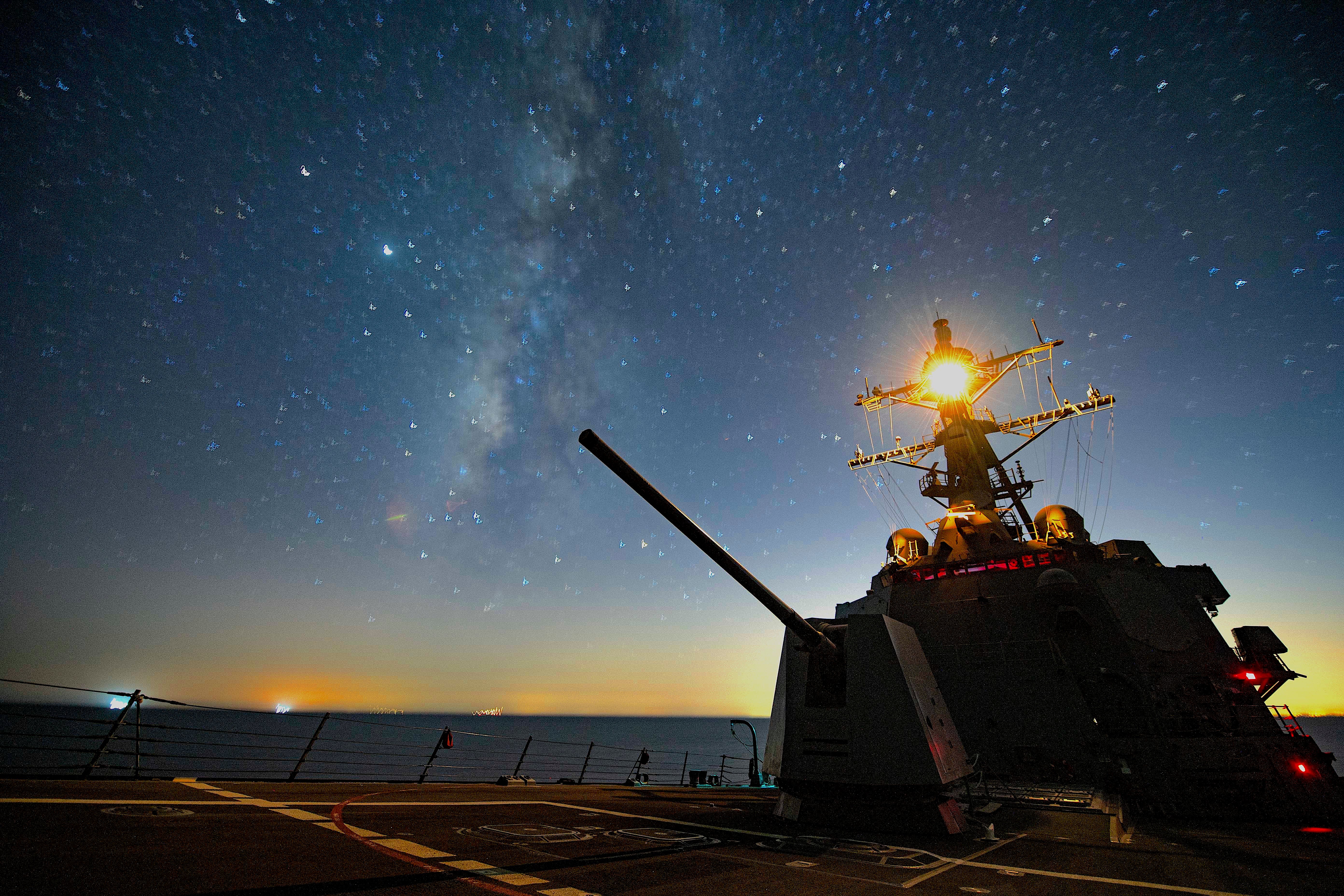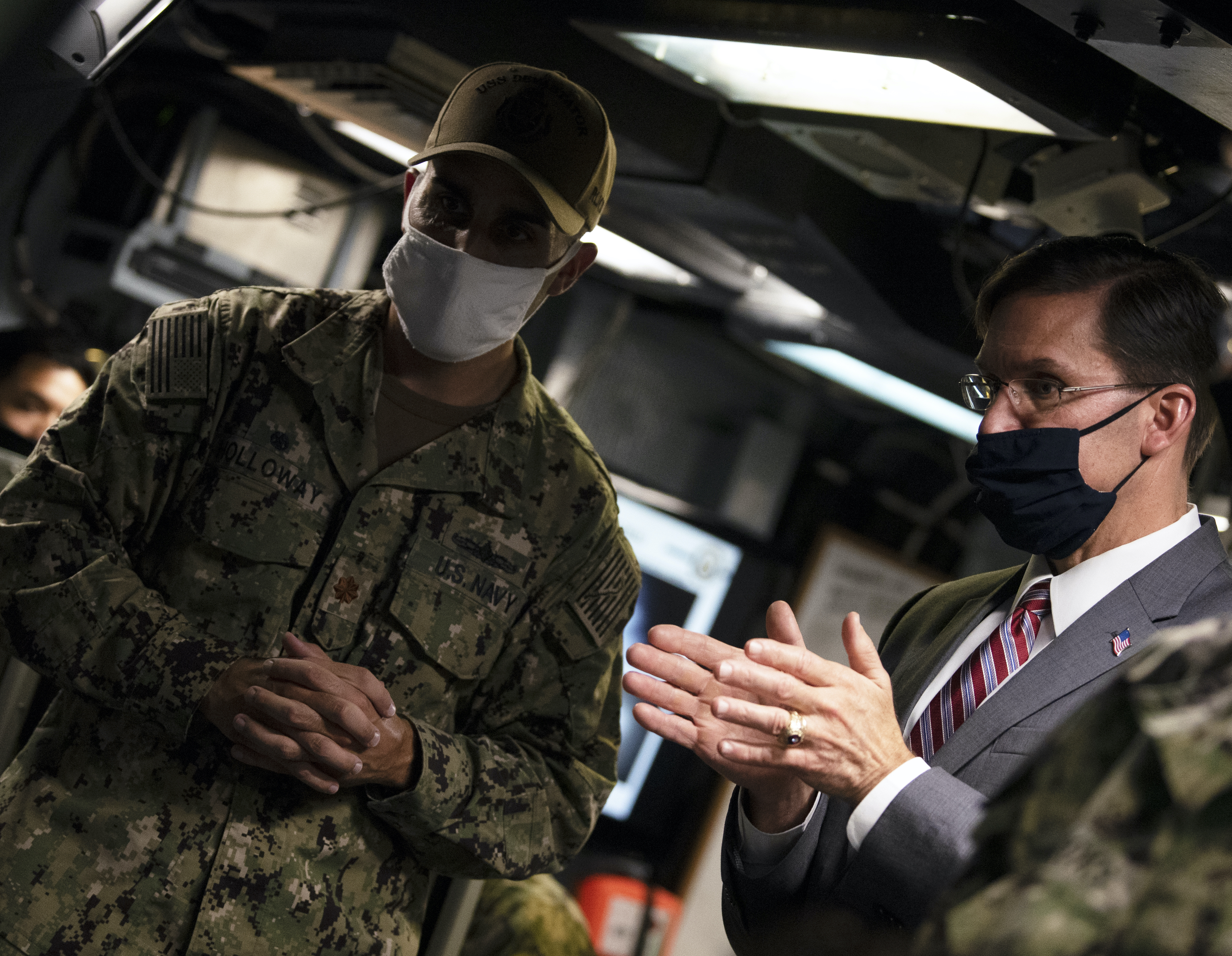
This post has been updated to include additional information from Adm. Gilday’s remarks.
After it took the better part of nine months to convince Mark Esper’s Pentagon that the naval force needed greater investment to be ready to deter or defeat China and Russia – even if that investment came at the expense of the Army or the Air Force – the Navy and Marine Corps will have to start anew with the incoming Biden administration, the chief of naval operations said today.
The two sea services in January wrapped up an extensive effort to plan out a future force design that would allow them to distribute small but lethal units across wide swaths of ocean, sensing and fighting their way through whatever obstacles an adversary could pose. But then-Defense Secretary Mark Esper was not convinced and said in no uncertain terms that if the Navy wanted to grow the fleet they’d have to find the money internally.
Even as of mid-summer, Esper still wasn’t convinced to increase Navy and Marine Corps topline, USNI News understands.
By late September, he changed his mind.
“Given the serious reform efforts put forward by the Secretary of the Navy and the Chief of Naval Operations – and their commitment to continue them – I agreed to provide additional funding from across the DoD enterprise, funding that was harvested from ongoing reform efforts such as Combatant Command reviews, Fourth Estate reforms, and other initiatives,” Esper said in early October when announcing the results of his Future Naval Force Study.
“Together, these additional funding streams will increase the shipbuilding account to 13 percent within the Navy’s topline, matching the average percentage spent for new ships during President Reagan’s buildup in the 1980s.”
However, Esper was fired just weeks after he started promising Cold War-era levels of investment in Navy shipbuilding.
“I think that we made a lot of progress in the last year with Secretary Esper and his staff in terms of coming to a place where there was a realization that we’ve under-invested in naval forces for too long and we needed to, not double down, but increase the investment in naval forces, perhaps at the expense of other areas. That we were making the argument that we believe we need overmatch in the maritime, based on the adversaries that we’re facing,” Chief of Naval Operations Adm. Mike Gilday said today while speaking at the U.S. Naval Institute’s annual Defense Forum Washington event.
“We think that our analysis withstood the rigors through the [Future Naval Force Study], in a CAPE-led analytical effort, and delivered an FNFS and discussions about a topline in [Fiscal Year 2022] that would support an increase in those investments.”
With a change in administration coming before that FY 2022 budget is released, “I think internally certainly we’ll have challenges again with the new administration in terms of explaining the rationale for making the investments in the naval force and heading down in the direction the commandant and I want to go in,” he said.
Esper’s vision for the future fleet included all the same elements the Navy and Marine Corps had touted in their own Integrated Naval Force Structure Assessment that Esper rejected in February – though the two plans differ in how aggressively they seek to overhaul the fleet from larger and more powerful platforms to smaller manned and unmanned ones that can distribute their offensive weapons and challenge an adversary’s targeting. It’s unclear if the future Biden administration would support high enough funding levels to make the changes as quickly as Esper had suggested he wanted to in his last weeks on the job.

Gilday said that, as the sea services modernize the fleet and grow in size, he would not do so at the expense of readiness.
“We can’t afford a navy much bigger than about 306 to 310 ships, based on the composition of the fleet that we have today. And so it is going to require more Navy topline. We have found money inside the Navy budget, but not enough to sustain that effort to give you the numbers that you really need to fight in a [Distributed Maritime Operations]/[Littoral Operations in a Contested Environment] fight,” he said during the event.
Gilday said the new fleet needs more submarines, fewer big surface combatants, more small combatants, more unmanned, more logistics ships, and a new composition for the amphibious fleet. He also needs to invest in future offensive technologies like hypersonic weapons and defensive technologies like lasers powerful enough to serve in a missile defense role.
Some of these efforts may take longer to fully realize, due to the long service lives of ships and the time it will take for larger combatants to age out and be replaced by smaller or unmanned ships.
Still, Gilday said there were some actions he wanted to get after on a quicker timeline: specifically, this decade he wants to deliver the Constellation-class frigate, design and begin building the “DDG Next” that will follow the Arleigh Burke-class destroyers, develop a network to tie manned and unmanned platforms together, and significantly scale up the unmanned presence in the fleet. For DDG Next, he said he hoped to see the design start in 2026 so that construction could begin in 2028, on the heels of the Arleigh Burke production line ending.
Navy Secretary Kenneth Braithwaite has promised billions of dollars in savings a year to help pay for some of these investments, with Esper promising something of a dollar-matching effort to help get the Navy where it needed to be. Braithwaite has on several occasions declined to say what cuts he’s eyeing or give a total dollar amount that can be reinvested in the future fleet.
Gilday said today he wanted to divest some legacy gear, such as the original four Littoral Combat Ships that the Navy uses just for mission package testing and would not deploy overseas. The CNO said he doesn’t want to put any more money into those ships when it could be used to buy more lethality for the fleet.
Additionally, Gilday said a second challenge the Navy faces today is convincing lawmakers to let the sea services move out quickly on new programs such as a light amphibious warship, small logistics ships, unmanned systems and more.

“I think we have challenges up on the Hill, particularly the Navy, with respect to unmanned. And with DDG Next,” he said, referring to the next large combatant that will follow the Flight III Arleigh Burke destroyers.
“So we are fighting the ghosts of our past, whether it’s LCS, Zumwalt, the challenges we’ve had with Ford – we need to explain how we’re not going to repeat the mistakes we’ve had in the past. And we can’t just say it, we have to show them what we are doing systematically to build a little bit, test a little bit, and then move to scaling – but when our confidence is high enough to do so.”
In a later panel, Naval Sea Systems Command chief Vice Adm. Bill Galinis detailed what his command is doing to help build that confidence in future systems.
On unmanned systems, he said the technology already exists and doesn’t need to be improved, they just need to do a lot of testing to prove out its reliability. He cited a recent trip by a large unmanned surface vessel from the Gulf Coast to California via the Panama Canal “with little to no manned intervention there.” He said NAVSEA and the Defense Department were pushing hard to prove and to improve the reliability and maturity of USVs and the components within them.
On more complex systems like the Columbia-class ballistic missile submarine, Galinis said NAVSEA is investing in significant land-based testing. In Philadelphia the Navy has built a propulsion plant and drive train to wring out the technology as individual components and as an integrated system. Similarly, on the Flight III destroyers, the Navy has now connected its first radar array to the new electrical system to ensure they can work together as a system.
Galinis added that, for the Navy’s newest ship program – the Constellation-class frigate – NAVSEA is still working through what kind of land-based testing and other prototyping efforts will be needed to drive down risk and raise confidence in the program.





